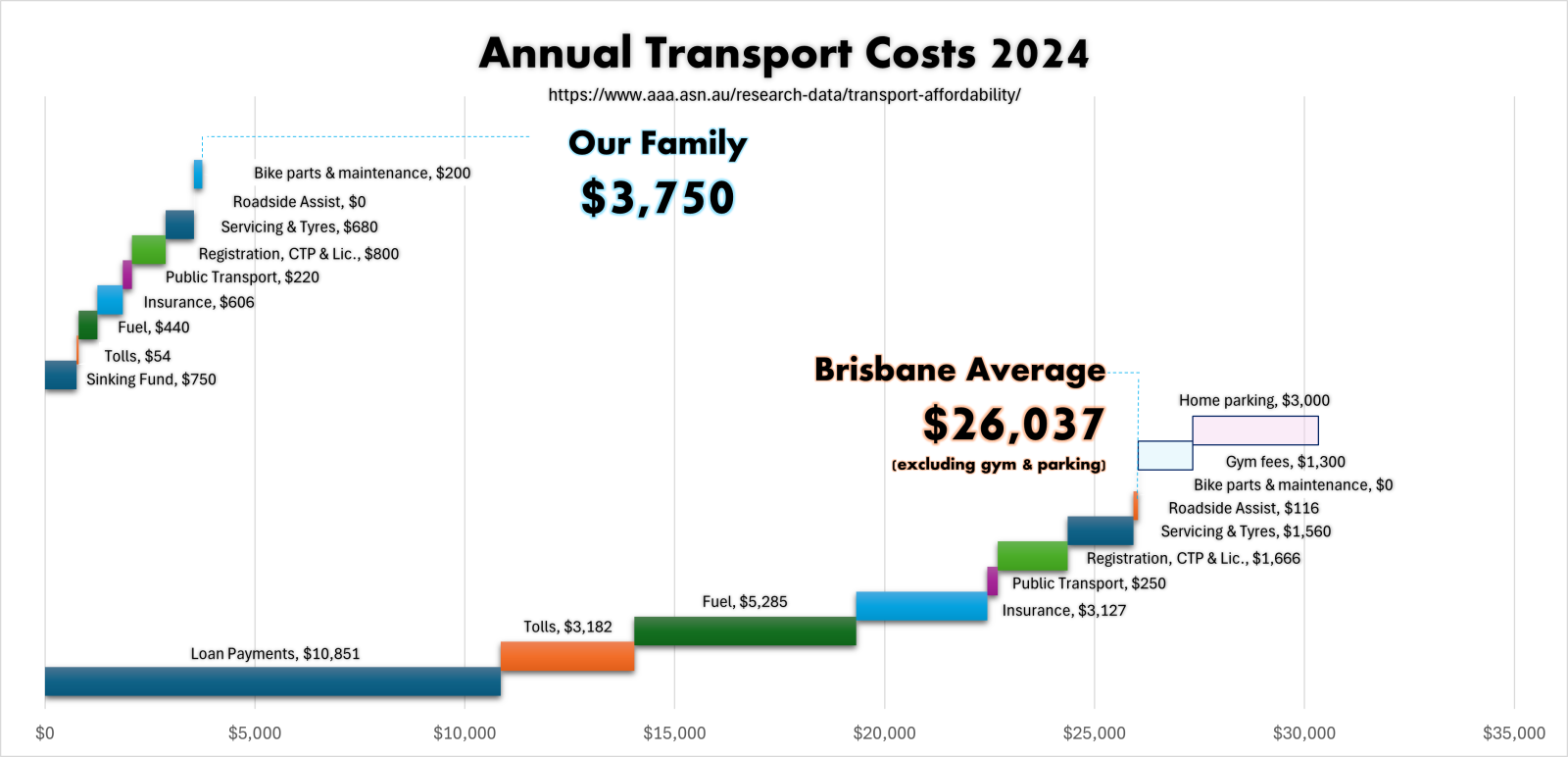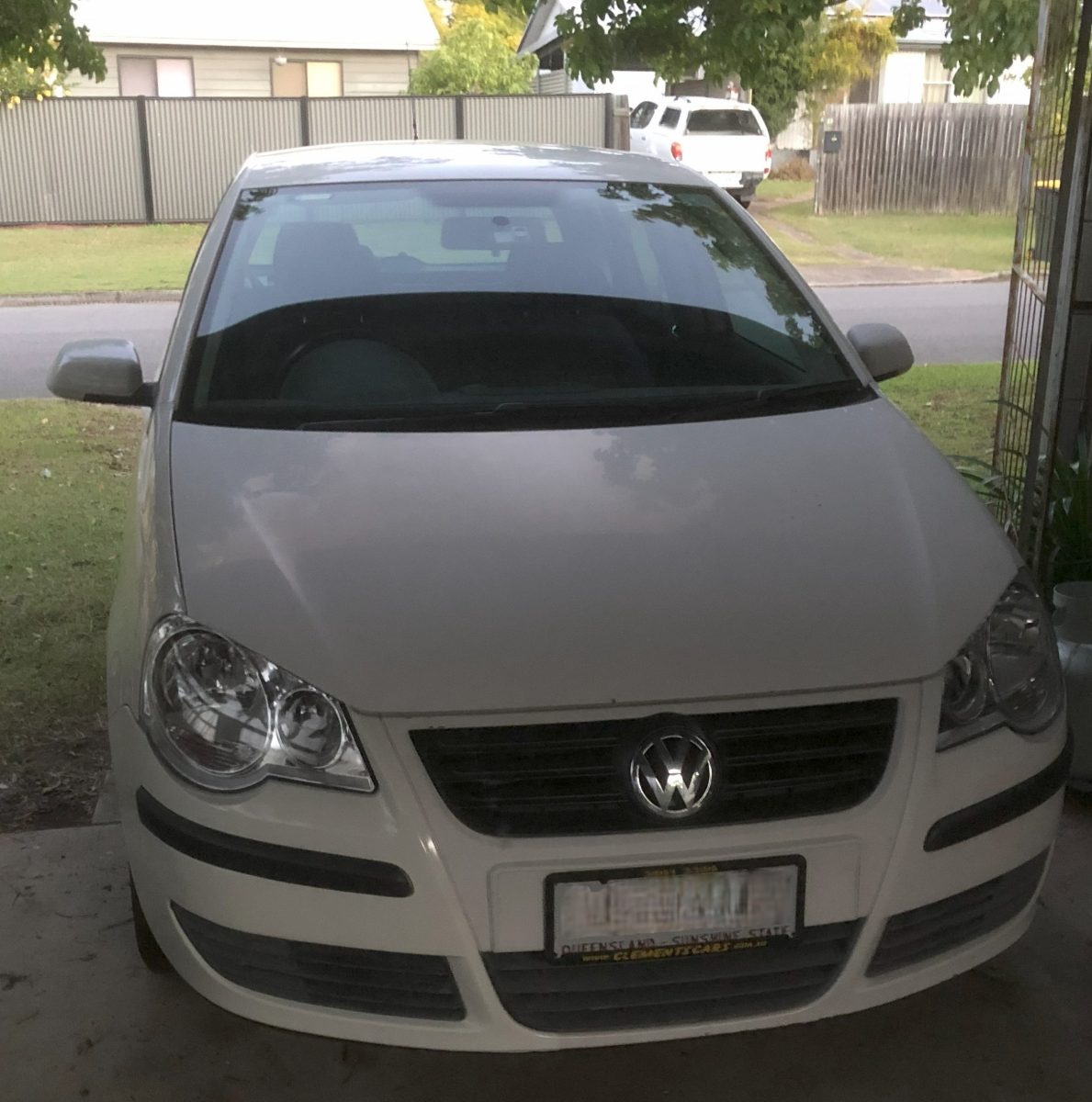Our most popular content has been related to money and in particular how we manage to give away such a substantial portion of our income while working so little and seemingly enjoying life so much. So I’m going to provide a bit more of a breakdown, starting with transport. Transport costs are often underappreciated, but for us, it is the single largest area of saving. For context transport costs are responsible for an average of $23,000 per year per household in Australia and over $26,000 for Brisbane. You could see why this conversation might be relevant, given our transport costs, including bike parts was just $3,000 last year or $3,750 when including a sinking fund for the eventual replacement of our car.

Other cost considerations I have added to this chart for reference include Australian average gym fees and home parking. The first of which may be avoided if the main reason for going is for aerobic fitness. The second because it has been demonstrated to substantially increase property costs. Note that public transport costs for this chart have been adjusted proportionately across the year to reflect the significant ticket price change which came at the end of the 2024 calendar year.
We do own a car, though we were determined not to. We bought it when Adam was a few months old after waiting four hours for an ambulance. It may not serve that emergency purpose so well anymore though. We have arranged our lives to avoid the need to use it to such an extent the battery is often low when we do go to take it out!
Our Trusty Old Car

We bought our car second-hand in 2012. It’s a compact, fuel-efficient turbo diesel hatchback with about 100,000km on the clock, a single previous owner and logbook servicing. Coming around to it’s 20th birthday this year, it still serves us well. There have been a couple of times when a repair quote has cost more than the car’s book value. But a well-maintained car isn’t worth its resale price. It’s worth the cost of reliably replacing it with something similarly trustworthy.
Replacing the car each time we faced an expensive repair would mean buying another second-hand car with unknown history, reliability issues, and potentially higher ongoing costs. By choosing to invest in maintaining the car we know, we’ve kept total costs much lower over the long term. We have also been able to find second hand or aftermarket parts in most cases, where performance was less critical, such as gas struts and headlamp covers. These cost less than 20% of the brand-name parts. On the flip side we have had all engine work completed by the licensed repairer.
Its not as pretty or fully featured as a new car. I have at times felt a little ashamed of the dents and the baggy door linings and the rubberised coating coming off the dashboard. But this is a perfect example of where I have to stop and remind myself again of the difference between want and need and the price and impossiblity of perfection. Our car, as dodgy as it is, represents a standard of comfort, convenience and luxury still unattainable for most of the world’s population (wiki). And as a point of gratitude, its helpful to consider how far personal transport has advanced in just the last century, let alone over the full 300,000 years of human history.
New vs Second-Hand: The Real Costs
The average new car price in Australia is a little over $50,000. Depreciation wipes $10,000 off in the first year and can burn another $5,000 per year beyond that in the initial years of ownership (Drive).
In contrast, a carefully chosen second-hand car of comparable specification comes in at under $30,000 thanks to that rapid initial depreciation. Aside from the smaller initial outlay which is a saving in itself, it also means lower interest costs, if finance is required and lower insurance costs. There is also the environmental costs of manufacturing a new car, which, for those conscious of their footprint, are substantial at 6,000 to 35,000kgCO2e depending on model and specifications.
How Big Do We Really Need?
While it can be frustrating to take a second car occasionally when you run out of seats and inconvenient to borrow a trailer, its worth considering how often these scenarios are really going to arise. Like many things in our lives, it is so easy to get caught up trying to cover every eventuallity, but when we do this, we end up with more than we need for most scenarios. We have a small (by today’s standards) 5 seat hatchback. While both kids were in booster seats, it certainly did get tight when we had someone else along, but this was really only a handful of times. A smaller car is cheaper to buy, insure, register and run, easier to park and better for the environment. With the combination of small and second hand we were able to purchase without finance. This is further savings over time on interest.
Environmental Costs
Cars are convenient but highly inefficient when you think of the energy they consume to move relatively small loads. We are using 100 million year old sunlight in the form of fossil fuels to move several tons of vehicle tens to hundreds of kilometers per day, often with just one or two people on board. Imagine if you had to push those tonnes yourself. Would you still take the car?
Every litre of petrol or diesel burnt releases roughly 2.3 to 2.7 kilograms of CO₂ (NTC). Our choice of a small turbo diesel car (5 to 6 litres per 100 km) means fewer emissions than the Australian average petrol car (typically 8–12 litres per 100 km). And electric vehicles, while more efficient, are not zero emission, even when charged from wind and solar. This will apply for as long as the grid is powered by a mix that includes fossil fuels. That charging energy could have been used instead to displace fossil energy on the grid.
With our modest annual driving, just 3,000 to 5,000 kilometres compared to the Australian average of around 12,000 km, we’ve reduced our carbon footprint significantly. If we drove more, we might consider upgrading to a second-hand electric vehicle or investigating a co-owning arrangement. But for our low annual travel, it’s currently more economical and environmentally sound to simply keep our existing vehicle running well.
Active and Public Transport: The Biggest Savings
The real secret to our low transport costs isn’t just the car, it’s how little we use it by the way we designed our lives.
We intentionally chose a small home in suburban Brisbane, just 10 minute bike ride from schools, shops, the train station, and sports venues. We even changed jobs to allow easier commuting by bike and train, as much to give us that time for other things, as for reducing our transport costs and emissions.
Brisbane’s public transport fares are also extremely low now at just 50 cents per trip, even for longer distances like the Gold Coast or Sunshine Coast. Pairing the train with bikes means that even family adventures or longer trips rarely involve the car, with trips to the beach a possibility for just a couple of dollars.
More Than Just Saving Money: Why We Love Active Travel
Riding bikes and catching trains isn’t just economical, it enriches our daily lives. On bikes, we connect with our surroundings and the natural environment, enjoying the health benefits of spending time outdoors. Daily or near daily cycling for 10 to 15 minutes each direction also meets health recommendations for physical activity. The time outside ensures exposure to sunlight for vitamin D production, at least during the warmer months. This has been linked to reduced incidence of all types of cancer (except skin), diabetes and neurodegenerative diseases (EHP). Part of our regular commutes also take us through green spaces, which has been shown to help boost both mental and physical health (NIHCR).
Our son, Adam, enjoys independence cycling to school, Scouts, and soccer training. We don’t lose hours driving him around, and he gains valuable confidence and autonomy. At least one adult gets along to his games and special events though – we ride there too or ride share with other families. Arriving at work or school having already exercised also means improved focus, better mood, and higher productivity and fewer cars on the school route improves road safety (The Lancet).
On trains, we chat, read, or simply relax. If travelling alone, it’s an ideal opportunity to unwind or strike up conversations with fellow travellers, something impossible while driving. When travelling with company, we get meaningful time together where we can offer each other full focus, a rare occurence in present times.
What Could You Do With $20,000 Saved Each Year?
Keeping transport costs low allows us to do something meaningful with our money instead of simply losing it to finance, fuel, and insurance. Each year, the thousands we save go directly into effective charities, changing real lives: supplying clean water, preventing malaria, restoring sight, and providing critical medical care (The Life You Can Save).
Our low car life-style is not always easy. There is often a little discomfort when explaining to other parents that we do actually have a car, but prefer not to use it. And if we offer to drive, it has mostly been received with awkward silence. But we’re getting there. Change starts somewhere and if it was easy we wouldn’t be talking about it. It would be wonderful if we could once again normalise sharing. In the meantime, by choosing our location and lifestyle thoughtfully, we’ve turned a financial drain into financial freedom. Our choices of owning and using less has given us the time and money to do more. What would you do?

We’re a family of 4 (in Melb), and have decided to have just one car, which seems pretty unusual these days. We manage by walking to kinder, getting the train to work and walking/biking when possible. Our car is also older, and pretty reliable. I sometimes also have moments of doubt when seeing friends driving nicer cars, but the idea of spending more time in the car is very off putting…
The stats on car ownership in countries such as Australia are pretty mind-boggling, but its also easy to see why they seem so essential when the infrastructure has had such an emphasis on driving. It’s nice to be able to break that cycle though and London, for example, is looking very promising with bike trips now outnumbering car trips!